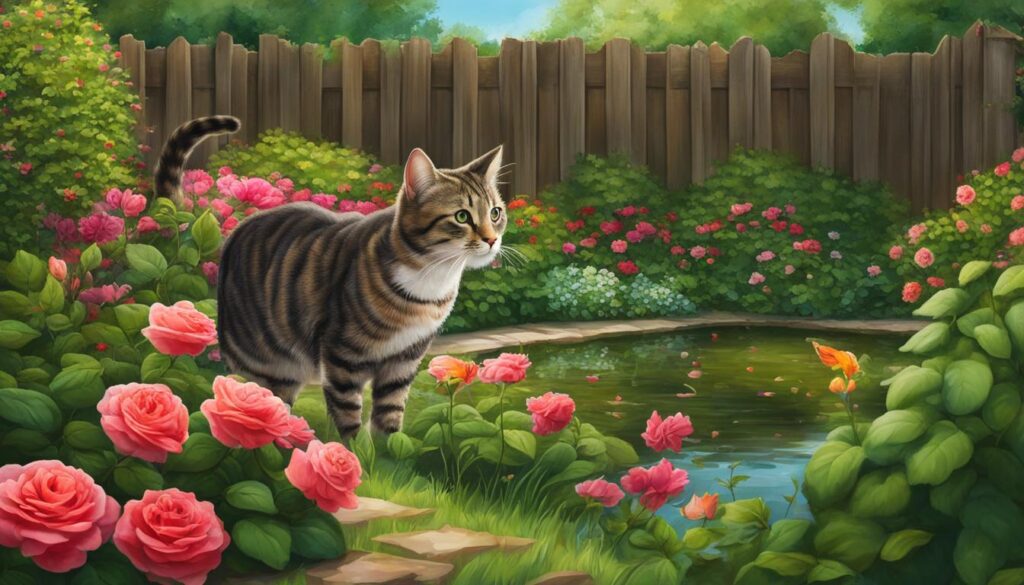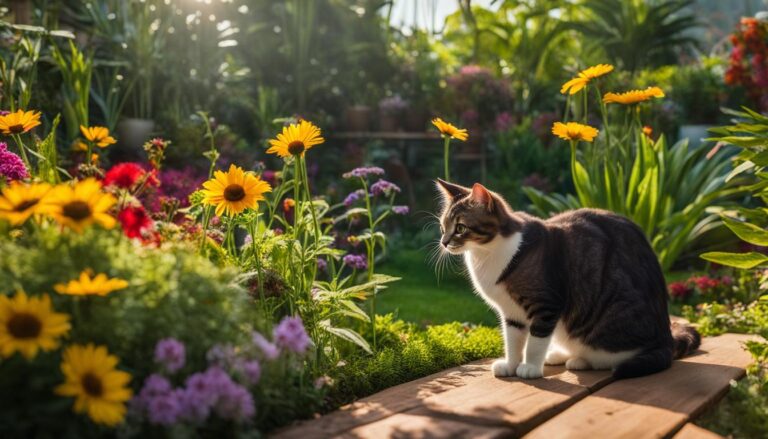Are you a cat owner who loves flowers? If so, you may be wondering if roses are safe to have around your furry friend. In this article, we will explore whether roses are toxic to cats and provide you with information on cat-safe flowers and plants.
Key Takeaways:
- Roses are not considered toxic to cats, but ingestion may cause gastrointestinal upset.
- The thorns on rose stems can cause trauma to a cat’s mouth if chewed, so it’s important to monitor your cat closely.
- Other cat-safe flowers include asters, celosia, orchids, snapdragons, sunflowers, and zinnias.
- Some safe plants for cats include areca palms, bamboo, Boston ferns, and spider plants.
- Be cautious of toxic plants like lilies and avoid exposing your cat to them.
Cat-Friendly Flowers and Plants
When it comes to adding a touch of nature to your home or garden, it’s important to consider the safety of your feline companion. Luckily, there are plenty of cat-friendly flowers and plants that you can enjoy without worrying about potential harm to your cat. These plants not only add beauty to your space but also provide a safe environment for your furry friend.
A list of cat-friendly flowers:
- Asters
- Celosia
- Orchids
- Snapdragons
- Sunflowers
- Zinnias
A list of cat-safe plants:
- Areca palms
- Bamboo
- Boston ferns
- Spider plants
These flowers and plants are known to be nontoxic to cats and can be enjoyed without the worry of potential harm. They provide a safe and vibrant environment for both you and your feline friend. However, it’s always a good idea to consult the ASPCA’s list of toxic and non-toxic plants to ensure the safety of your cat.
Potential Dangers and Precautions
While roses are considered safe for cats, it is essential to be cautious of other flowers and plants that can be toxic to feline companions. Lilies, such as those from the Lilium Sp, are highly toxic to cats and can cause acute kidney failure. It is crucial to keep all lilies out of your home if you have cats. Additionally, there are some flowers with “rose” in their name, such as Christmas rose, desert rose, moss rose, primrose, rosebay, and rose of Sharon, that should be avoided as they may be harmful to cats. Furthermore, be aware of chemicals sprayed onto flowers, such as pesticides and insecticides, as they can pose a serious risk to cats if ingested. It is recommended to use organic, pesticide-free flowers and plants to ensure the safety of your cat.
Common Toxic Flowers and Plants for Cats
| Flower/Plant | Toxicity Level |
|---|---|
| Lily | Highly toxic |
| Christmas Rose | Potentially harmful |
| Desert Rose | Potentially harmful |
| Moss Rose | Potentially harmful |
| Primrose | Potentially harmful |
| Rosebay | Potentially harmful |
| Rose of Sharon | Potentially harmful |
It is important to be familiar with these hazardous flowers and plants to protect the well-being of your feline friend. Cats are curious creatures and may come into contact with these potentially harmful substances without your knowledge. Therefore, it is crucial to educate yourself about the toxicity levels of various flowers and plants and ensure they are not within your cat’s reach. By doing so, you can provide a safe and secure environment for your beloved pet.
“Cats are curious creatures and may come into contact with potentially harmful flowers and plants without your knowledge.”
Creating a Cat-Safe Environment
To ensure the safety and well-being of your feline friend, it’s important to create a cat-safe environment in your home and garden. By taking a few simple precautions, you can provide a space that allows your cat to explore and enjoy their surroundings without any potential dangers.
1. Pet-Friendly Garden
If you have an outdoor space, consider creating a pet-friendly garden where your cat can safely roam and play. One way to achieve this is by planting safe plants for cats, such as catnip, catmint, or lavender. These plants not only provide sensory stimulation for your cat but are also non-toxic if ingested. Avoid planting any toxic plants or flowers, such as lilies, daffodils, or tulips, which can be harmful to your furry friend.
In addition to selecting cat-safe plants, it’s important to avoid using pesticides or fertilizers that may be toxic to cats. Instead, opt for organic alternatives to maintain the health of your plants and the safety of your cat. Creating a designated area with soft grass or cat-friendly turf can also provide an outlet for your cat’s natural instinct to chew on grass without the risk of ingesting harmful substances.
2. Cat-Proofing Your Home
Indoor cats also require a cat-proofed environment to ensure their safety. Start by securing any planters or vases to prevent your cat from knocking them over and potentially ingesting toxic plants or flowers. Remove any plants that are known to be toxic from your home or place them in areas that are inaccessible to your cat, such as high shelves or hanging them from the ceiling.
Consider providing elevated surfaces, such as tall trees or shelves, for your cat to perch on. This not only creates additional vertical space for your cat to explore but also helps keep them away from plants that may pose a risk. Providing alternative forms of entertainment, such as bird feeders or baths, can help distract your cat from any plants that may still be within their reach.
3. Regular Monitoring
Even with all the necessary precautions, it’s important to regularly monitor your cat for any signs of distress or illness. Keep an eye out for any unusual behavior, changes in appetite, or physical symptoms such as vomiting or diarrhea. If you notice any concerning symptoms or suspect your cat has ingested something toxic, it’s crucial to seek veterinary advice immediately.

In conclusion, creating a cat-safe environment involves careful consideration of the plants and flowers in your home and garden, as well as implementing measures to prevent any potential dangers. By choosing cat-friendly plants, securing planters and vases, and providing elevated surfaces for your cat, you can ensure they can safely enjoy their surroundings. Regular monitoring and prompt veterinary attention are essential for maintaining your cat’s health and well-being.
Conclusion
In conclusion, this pet lover’s guide to feline health emphasizes the importance of keeping your cats safe from toxic plants. While roses themselves are generally safe for cats, it’s crucial to remove thorns and monitor your furry friend for any gastrointestinal symptoms if they come into contact with them. However, it’s essential to be aware of other flowers and plants that can be harmful to cats, such as lilies and certain species with “rose” in their name.
To create a cat-friendly environment, opt for cat-safe flowers and plants like asters, orchids, and Boston ferns. Consult reputable sources like the ASPCA for a comprehensive list of toxic and non-toxic plants to ensure your cat’s safety. Take precautions by cat-proofing your home and garden, such as securing planters and providing elevated places for your cat to perch. Avoid using chemical sprays on your plants and opt for organic, pesticide-free options.
By following these guidelines, you can enjoy the beauty of flowers and plants while keeping your feline companion safe and healthy. Remember, your cat’s well-being is of utmost importance, so always take the necessary steps to create a pet-friendly environment. With a little bit of care and attention, you can create a haven where you and your cat can thrive together.




